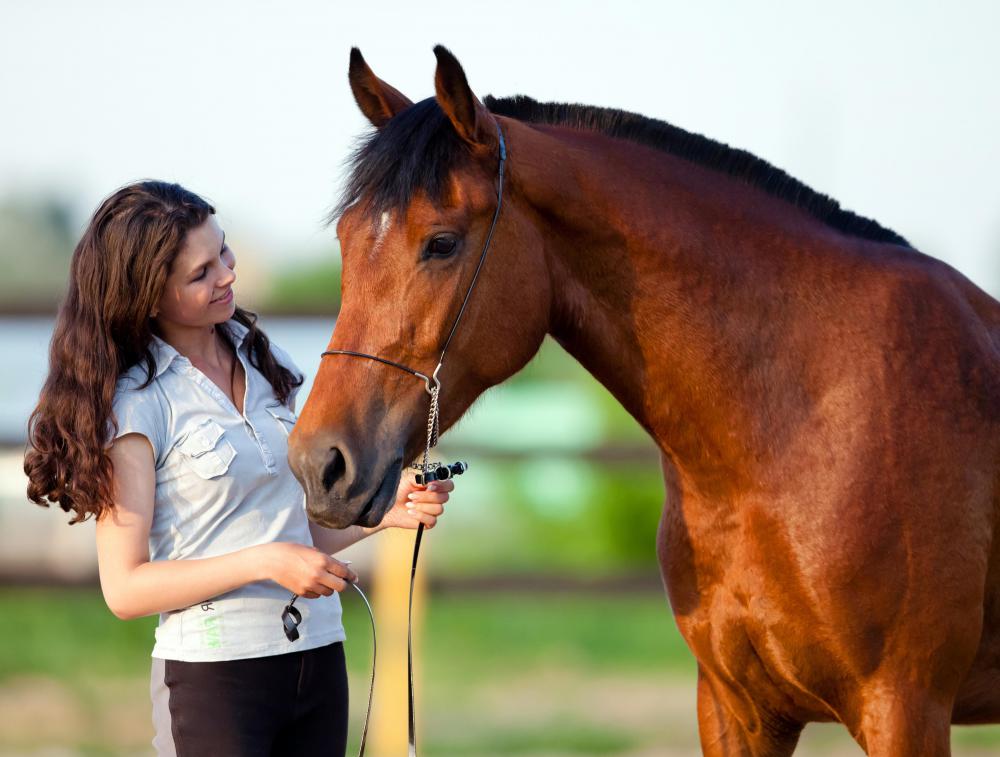At AllThingsNature, we're committed to delivering accurate, trustworthy information. Our expert-authored content is rigorously fact-checked and sourced from credible authorities. Discover how we uphold the highest standards in providing you with reliable knowledge.
What is Tellington Touch?
Tellington Touch, also know as TTouch or T-Touch, is a type of natural horsemanship developed by Linda Tellington-Jones. To someone who is new to the discipline, Tellington Touch appears to be a combination of horse training and horse massage. Although training is one of its primary functions, it is also used for the horse’s well being. For example, TTouch methods can be used to relax a horse, reduce muscle strain, and prevent injuries.
The Tellington Touch is based on the premise that what is often interpreted as behavior or attitude problems are actually the horse trying to tell us that they are hindered by pain or fear. For example, a horse that is sore from an aggressive riding session the previous day may be pained by the saddle, and may act out as a result of that pain. Tellington Touch methods are designed to soothe sore muscles and release tension buildup, removing a horse’s reasons for acting out.

As another example, Tellington Touch can also be used on horses that won’t stand still while being groomed. Some horses are ticklish or find certain parts of being groomed to be very uncomfortable; just like humans, they may try to avoid the sensation by moving away from it, either with just their skin or with their entire bodies. TTouch methods can help relax a ticklish or tense horse, acclimating him or her to the sensation of being groomed.
Tellington Touch also helps to keep horses limber and prepare them for a difficult workout. Just like people, horses need to stretch their muscles before exercising in order to avoid causing soreness or even injury. This is especially important for stall-bound horses, as they don’t have as much freedom of movement as a pasture-kept horse. A horse’s handler can use TTouch to help stimulate and warm up the horse’s muscles.
One of the fundamental techniques of Tellington Touch is to move your hand in small circles on your horse’s skin, just as if you were giving him a massage. The circles may require light, medium, or heavy pressure, depending on what you want to achieve. Each circle starts at the bottom, such as where the 6 is on a clock, and moves clockwise until your hand gets to where the 9 would be. The key here is to actually move the horse’s skin, rather than just rubbing the surface.
The Abalone TTouch is an example of a Tellington Touch technique. The whole hand is used to apply light pressure to the horse’s skin, moving it in circles as described above. Depending on how the Abalone TTouch is used, this technique can be used to either relax or stimulate a horse. Slower circles are more soothing, while faster circles cause a horse to become more alert.
The Mouth TTouch is another well-known technique. Once they become accustomed to the new sensation, many horses enjoy having the insides of their mouths and nostrils massaged. Tellington Touch has adapted this technique to acclimate a horse to having his mouth touched during procedures such as deworming and dental work.
There are many other techniques used in Tellington Touch, each with a unique purpose. TTouch can be used as a training aid, a method of promoting a horse’s well being, or simply as a way for horse and handler to bond.
Frequently Asked Questions
What is Tellington Touch and how does it benefit animals?
Tellington Touch, often abbreviated as TTouch, is a gentle and respectful method of touch and movement exercises designed to enhance an animal's well-being and behavior. Developed by Linda Tellington-Jones, it helps reduce stress and anxiety, fosters deeper human-animal connections, and supports the animal's ability to learn and adapt to new situations. It's particularly beneficial for animals with fear or aggression issues.
Can Tellington Touch be used on all types of animals?
Yes, Tellington Touch is versatile and can be applied to a wide range of animals, including dogs, cats, horses, and even exotic species. Each technique is adapted to suit the specific animal's size, sensitivity, and responsiveness. This adaptability makes TTouch a valuable tool for animal caretakers, trainers, and therapists across various species.
How does Tellington Touch differ from traditional pet massage?
While pet massage primarily focuses on muscle relaxation through direct pressure, Tellington Touch encompasses a broader range of techniques that include circular touches, lifts, and slides to stimulate the nervous system and enhance body awareness. TTouch is also known for its unique approach to movement exercises and equipment that encourage balance and confidence.
Is Tellington Touch scientifically supported?
While empirical research on Tellington Touch is still growing, several studies and anecdotal evidence suggest positive outcomes in reducing anxiety and improving behavior. For instance, a study published in the Journal of Applied Animal Welfare Science observed reduced fear responses in shelter dogs after TTouch sessions. Ongoing research continues to explore its efficacy and mechanisms.
Do you need to be certified to practice Tellington Touch on animals?
While anyone can learn the basics of Tellington Touch to use on their own pets, professional practice typically requires certification. The Tellington TTouch Training offers various levels of certification, ensuring practitioners are well-versed in the techniques and philosophy behind TTouch to provide the most benefit to the animals they work with.
How often should Tellington Touch be applied to see results?
The frequency of Tellington Touch sessions can vary depending on the individual animal and its specific needs. Some may show immediate improvement, while others benefit from regular sessions over a period of time. Consistency is key, and many practitioners recommend incorporating TTouch into the animal's daily routine for optimal results.
AS FEATURED ON:
AS FEATURED ON:











Discuss this Article
Post your comments